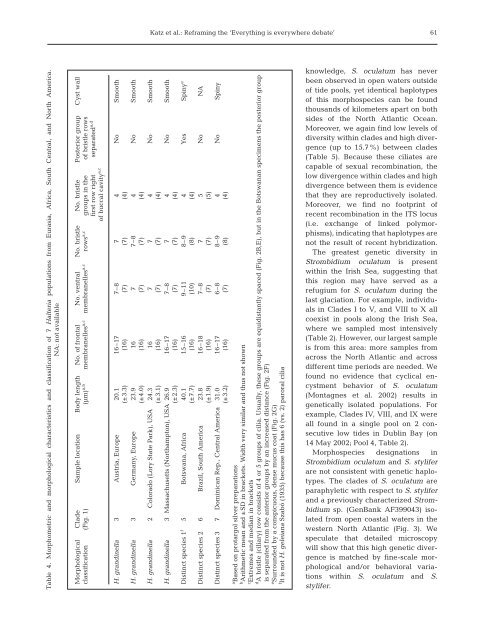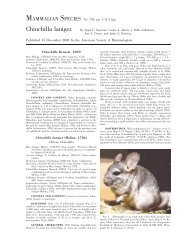Reframing the 'Everything is everywhere'debate: evidence for high ...
Reframing the 'Everything is everywhere'debate: evidence for high ...
Reframing the 'Everything is everywhere'debate: evidence for high ...
You also want an ePaper? Increase the reach of your titles
YUMPU automatically turns print PDFs into web optimized ePapers that Google loves.
Katz et al.: <strong>Reframing</strong> <strong>the</strong> ‘Everything <strong>is</strong> everywhere debate’<br />
61<br />
Table 4. Morphometric and morphological character<strong>is</strong>tics and classification of 7 Halteria populations from Eurasia, Africa, South Central, and North America.<br />
NA: not available<br />
Morphological Clade Sample location Body length No. of frontal No. ventral No. br<strong>is</strong>tle No. br<strong>is</strong>tle Posterior group Cyst wall<br />
classification (Fig. 1) (µm) a,b membranelles a,c membranelles a,c rows a,c groups in <strong>the</strong> of br<strong>is</strong>tle rows<br />
first row right separated a,d<br />
of buccal cavity a,c<br />
H. grandinella 3 Austria, Europe 20.1 16–17 7–8 7 4 No Smooth<br />
(±3.3) (16) (7) (7) (4)<br />
H. grandinella 3 Germany, Europe 23.9 16 7 7–8 4 No Smooth<br />
(±4.0) (16) (7) (7) (4)<br />
H. grandinella 2 Colorado (Lory State Park), USA 24.3 16 7 7 4 No Smooth<br />
(±3.1) (16) (7) (7) (4)<br />
H. grandinella 3 Massachusetts (Northampton), USA 26.9 16–17 7–8 7 4 No Smooth<br />
(±2.3) (16) (7) (7) (4)<br />
D<strong>is</strong>tinct species 1 f 5 Botswana, Africa 40.1 15–16 9–11 8–9 4 Yes Spiny e<br />
(±7.7) (16) (10) (8) (4)<br />
D<strong>is</strong>tinct species 2 6 Brazil, South America 23.8 16–18 7–8 7 5 No NA<br />
(±1.9) (16) (7) (7) (5)<br />
D<strong>is</strong>tinct species 3 7 Dominican Rep., Central America 31.0 16–17 6–8 8–9 4 No Spiny<br />
(±3.2) (16) (7) (8) (4)<br />
a Based on protargol silver preparations<br />
b Arithmetic mean and ±SD in brackets. Width very similar and thus not shown<br />
c Extremes and median in brackets<br />
d A br<strong>is</strong>tle (ciliary) row cons<strong>is</strong>ts of 4 or 5 groups of cilia. Usually, <strong>the</strong>se groups are equid<strong>is</strong>tantly spaced (Fig. 2B,E), but in <strong>the</strong> Botswanan specimens <strong>the</strong> posterior group<br />
<strong>is</strong> separated from <strong>the</strong> anterior groups by an increased d<strong>is</strong>tance (Fig. 2F)<br />
e Surrounded by a conspicuous, dense mucus coat (Fig. 2G)<br />
f It <strong>is</strong> not H. geleiana Szabó (1935) because th<strong>is</strong> has 6 (vs. 2) paroral cilia<br />
knowledge, S. oculatum has never<br />
been observed in open waters outside<br />
of tide pools, yet identical haplotypes<br />
of th<strong>is</strong> morphospecies can be found<br />
thousands of kilometers apart on both<br />
sides of <strong>the</strong> North Atlantic Ocean.<br />
Moreover, we again find low levels of<br />
diversity within clades and <strong>high</strong> divergence<br />
(up to 15.7%) between clades<br />
(Table 5). Because <strong>the</strong>se ciliates are<br />
capable of sexual recombination, <strong>the</strong><br />
low divergence within clades and <strong>high</strong><br />
divergence between <strong>the</strong>m <strong>is</strong> <strong>evidence</strong><br />
that <strong>the</strong>y are reproductively <strong>is</strong>olated.<br />
Moreover, we find no footprint of<br />
recent recombination in <strong>the</strong> ITS locus<br />
(i.e. exchange of linked polymorph<strong>is</strong>ms),<br />
indicating that haplotypes are<br />
not <strong>the</strong> result of recent hybridization.<br />
The greatest genetic diversity in<br />
Strombidium oculatum <strong>is</strong> present<br />
within <strong>the</strong> Ir<strong>is</strong>h Sea, suggesting that<br />
th<strong>is</strong> region may have served as a<br />
refugium <strong>for</strong> S. oculatum during <strong>the</strong><br />
last glaciation. For example, individuals<br />
in Clades I to V, and VIII to X all<br />
coex<strong>is</strong>t in pools along <strong>the</strong> Ir<strong>is</strong>h Sea,<br />
where we sampled most intensively<br />
(Table 2). However, our largest sample<br />
<strong>is</strong> from th<strong>is</strong> area: more samples from<br />
across <strong>the</strong> North Atlantic and across<br />
different time periods are needed. We<br />
found no <strong>evidence</strong> that cyclical encystment<br />
behavior of S. oculatum<br />
(Montagnes et al. 2002) results in<br />
genetically <strong>is</strong>olated populations. For<br />
example, Clades IV, VIII, and IX were<br />
all found in a single pool on 2 consecutive<br />
low tides in Dublin Bay (on<br />
14 May 2002; Pool 4, Table 2).<br />
Morphospecies designations in<br />
Strombidium oculatum and S. stylifer<br />
are not cons<strong>is</strong>tent with genetic haplotypes.<br />
The clades of S. oculatum are<br />
paraphyletic with respect to S. stylifer<br />
and a previously characterized Strombidium<br />
sp. (GenBank AF399043) <strong>is</strong>olated<br />
from open coastal waters in <strong>the</strong><br />
western North Atlantic (Fig. 3). We<br />
speculate that detailed microscopy<br />
will show that th<strong>is</strong> <strong>high</strong> genetic divergence<br />
<strong>is</strong> matched by fine-scale morphological<br />
and/or behavioral variations<br />
within S. oculatum and S.<br />
stylifer.
















